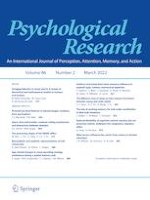11-04-2021 | Original Article
Nonsymbolic and symbolic representations of null numerosity
Gepubliceerd in: Psychological Research | Uitgave 2/2022
Log in om toegang te krijgenAbstract
Previous research has shown that null numerosity can be processed as a numerical entity that is represented together with non-null numerosities on the same magnitude system. The present study examined which conditions enable perceiving nonsymbolic (i.e., an empty set) and symbolic (i.e., 0) representations of null numerosity as a numerical entity, using distance and end effects. In Experiment 1, participants performed magnitude comparisons of notation homogeneous pairs (both numerosities appeared in nonsymbolic or symbolic format), as well as heterogeneous pairs (a nonsymbolic numerosity versus a symbolic one). Comparisons to 0 resulted in faster responses and an attenuated distance effect in all conditions, whereas comparisons to an empty set produced such effects only in the nonsymbolic and symbolic homogeneous conditions. In Experiments 2 and 3, participants performed same/different numerosity judgments with heterogeneous pairs. A distance effect emerged for "different" judgments of 0 and sets of 1 to 9 dots, but not for those with an empty set versus digits 1–9. These findings indicate that perceiving an empty set, but not 0, as a numerical entity is determined by notation homogeneity and task requirements.
